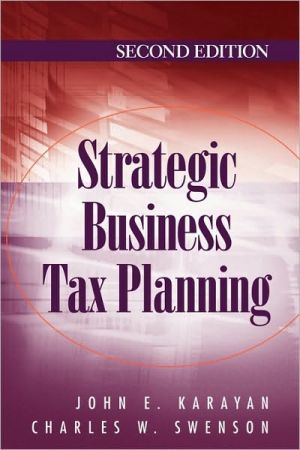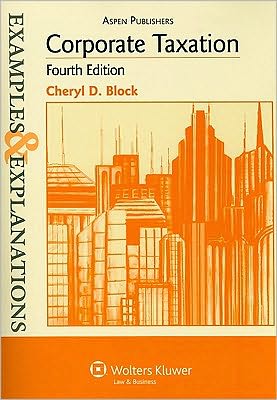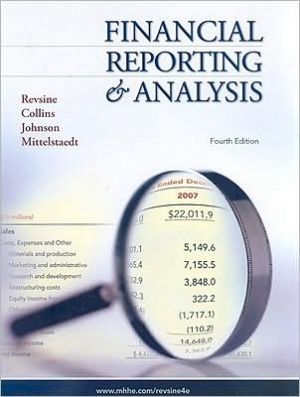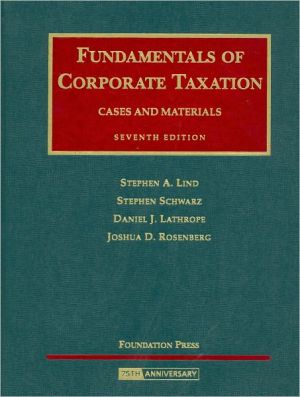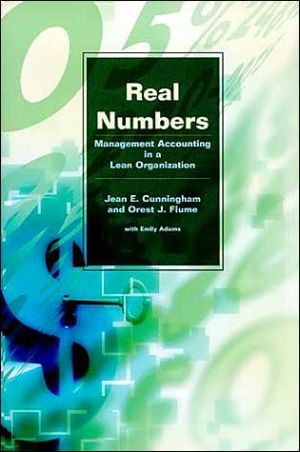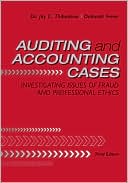Business Tax Planning 2e
Strategic Business Tax Planning, Second Edition is the definitive handbook on business tax planning, skipping the unnecessary and minute taxation details and focusing instead on the big picture in taxes. Organized around business processes, this reader-friendly guide shows you how to optimally put tax management principles to work in your business.
Search in google:
Strategic Business Tax Planning, Second Edition is the definitive handbook on business tax planning, skipping the unnecessary and minute taxation details and focusing instead on the big picture in taxes. Organized around business processes, this reader-friendly guide shows you how to optimally put tax management principles to work in your business.
Strategic Corporate Tax Planning\ \ By John E. Karayan Charles W. Swenson Joseph W. Neff \ John Wiley & Sons\ ISBN: 0-471-22075-2 \ \ \ Chapter One\ A Framework for Understanding Taxes \ The claim that information would define the future reminded me of the famous party scene in the 1967 movie The Graduate. A businessman buttonholes Benjamin, the college graduate played by Dustin Hoffman, and offers him a single word of unsolicited career advice: "plastics." I wondered whether, if the scene had been written a few decades later, the businessman's advice would have been: "One word, Benjamin: 'information.'" -Bill Gates, The Road Ahead\ How much are people and organizations touched by taxes? Think about what people do every day. Buy a cup of coffee, and some sort of sales or value-adding tax is almost certainly included in the amount paid. Make a telephone call, and an excise tax is likely incurred. Earn income, and a significant portion of the compensation must usually be withheld for payroll taxes. Make money trading stocks over the Web, and a percentage of the profits will likely be dedicated to annual income taxes.\ One conclusion that can be drawn from this thought experiment is that taxes seem to be everywhere, embedded in every transaction. This conclusion can be supported by the following set of simple experiments on the World Wide Web. First, get on a Web browser (e.g., Netscape or Explorer) and run an Internet search on the word "taxes." Consider the sheernumber of hits generated by this simple task. Run the search again on the Web site of a national newspaper (such as nytimes.com or economist. com). How many articles discuss taxes? Finally, explore one of the gateway Web sites in taxation (e.g., taxsites.com or taxworld.org). As you may already know, a gateway is a Web site that consists primarily of links to other Web sites. Gateways are particularly handy for keeping track of the constant changes in Web addresses and for finding new sites. Be sure to look at the Web site for the U.S. Internal Revenue Service (IRS), irs.gov, which was one of the first major sites for a governmental agency and is one of the most heavily used. Browse the various publications available there. How many are there? Other very interesting sites to explore are the U.S. Federal income tax calculator, nettax.com, and the free tax return preparation site, hdvest.com. It also may be worth your time and effort to view the history of taxation found at uic.edu/depts/ lib/collections/govdocs/tax/taxhistory.html, and the "Hot Topics in Taxation" page of the University of Michigan's Office of Tax Policy Research at 209.69.116.53.\ One reason that taxes seem to be everywhere may be that they are a price paid for government. Not the total price: To some extent (and in many ways, both directly and indirectly), governments support themselves by charging users for specific services provided. For example, some local governments charge a monthly fee to owners of residences that are hooked up to municipal sewer systems. However, throughout the world governments are primarily financed through taxation. Taxes are charges not directly related to goods or services provided, which are imposed on people and organizations located within a government's legal reach. In many locations in the industrialized world, a multitude of governments and their subdivisions-ranging from cities to nations, school districts to metropolitan rapid transit districts-levy a myriad of taxes on a wide variety of activities, such as income taxes on business profits, property taxes on wealth, value-adding taxes on purchases, and payroll taxes on compensation.\ Some taxes are periodic. For example, payroll taxes on employees are usually withheld from each paycheck, and income taxes are typically based on one year's earnings. Other taxes are generated if and only if certain transactions occur. For example, sales taxes are usually triggered by the retail sales of goods, and inheritance taxes may arise when title to property is passed to a person's heirs.\ The primary purpose of most taxes is to raise revenue to finance governments. But because taxes impose costs on transactions, taxes affect people's behavior, and thus can (and are) used by governments to try to shape society. Indeed, the primary purpose of some taxes-such as excise taxes on the sale of machine guns, tobacco, and pollutants-is to further social engineering goals.\ Taxes seem to be everywhere, and triggered by a bewildering array of activities, but how is strategic tax planning important to people who do not devote their lives to tax consulting?\ HOW ARE TAXES IMPORTANT IN DECISION MAKING?\ Sometimes taxation, and thus tax planning, is one of the most important factors in decision making. Consider the following scenario. Your best friend, who lives in New York City, e-mails you with the news that she has just inherited a large amount of cash. She asks for your help in investing it in U.S. mutual funds, which primarily hold bonds. Look in a financial newspaper or Web site that shows the current earnings of various bond funds. Pick five at random, and calculate their average yield. Now do the same for five that have the words "tax exempt" or "municipal" in their names. (For the uninitiated, this means that these funds invest primarily in bonds issued by U.S. states and local government agencies. Interest paid on such securities is almost always exempt from U.S. federal income tax, and is often exempt from state income taxes as well.) What is the difference in the average yields of the first set of mutual funds and the tax-exempt set? Could a significant part of this difference be accounted for by tax effects?\ Tax planning can affect decision making in even the most commonplace of settings. Consider the case of a typical U.S. homeowner whose annual property tax payment must be paid before January of the following year, and it is now December. Almost all people who pay U.S. federal income tax calculate the tax based on their net income-that is, their taxable revenues less their tax-deductible expenses-in each calendar year. Assume that the property tax is a deductible expense, and that the homeowner is in the 28% tax bracket. This means that every dollar of additional income results in $.28 in additional tax. Similarly, every dollar of tax-deductible expense saves $.28 in taxes. If homeowners pay the property tax in December, they will get a tax deduction on their tax returns for the current year. The tax benefit is delayed a year, however, if they wait until January to pay. That is, simply paying this deductible expense a few days earlier generates tax savings a year earlier. This simple bit of planning results in tax benefits through timing, an important component of strategic tax planning discussed in detail throughout this book.\ Taxes can even affect the most nonfinancial of decisions. Consider the case of two people who want to get married. Should they be thinking about taxes? Suppose that each will earn about $30,000 of taxable income for the current year. If they stay single, each would owe a little over $5,100 of U.S. income tax for the year. Unmarried, about $10,200 of tax would be generated on their total income of $60,000. However, if they are married at the end of the year, their total tax bill would exceed $11,300. That is, the decision to get married would cost them over $1,000 in U.S. federal income taxes that year. (Note: federal tax liability can be quickly calculated in a variety of ways. One way is to use the tax tables provided by the IRS. These can be found on its Web site at irs.gov by clicking on "Forms and Publications," selecting "Forms and Instructions," and reviewing "Instructions 1040 [Tax Tables]. Another way is to purchase tax-preparation software or use Web-based programs such as those found at hdvest.com or nettax.com.)\ Reducing marriage penalties like this has been a perennial target of tax legislation during the past few years. Under the Tax Relief Reconciliation Act of 2001, for example, there are two changes in this area. First, on joint returns-that is, where married couples elect to file one tax return that combines their incomes-the standard deduction (discussed later in this chapter) is being changed. Currently, it is about 85% of that for two single filers. It is being increased to double that of single filers. This is being phased in over a four-year period starting in 2005 and ending in 2008. The current numbers are:\ Standard Deduction\ Filing Married Head of Married Filing Status Filing Jointly Single Household Separately\ 2001 $7,600 $4,550 $6,650 $3,800 2002 $7,850 $4,700 $6,900 $3,925\ Two years are shown here so the gradual, across-the-board increases due to inflation indexing can be seen. Indexing applies to a variety of, but not all, fixed dollar amounts in U.S. tax law, such as the standard deduction, as well as that rate brackets.]\ The second change is that the amount being taxed at the 15% rate for joint filers is being expanded. This is so that the upper limit of amount taxed at 15%-the so-called 15% bracket-will become twice that for single taxpayers, rather than the current 85%. The current rates are:\ Tax Year 2002 Married Filing Jointly Unmarried Taxable Income Rate Taxable Income Rate First $12,000 10% Not over $6,000 10% of the taxable income\ Over $12,000 $1,200 plus 15% Over $6,000 $600 plus 15% of but not over of the excess but not over the excess over $46,700 over $12,000 $27,950 $6,000 Over $46,700 $6,405 plus 27% Over $27,950 $3,892.50 plus but not over of the excess but not over 27% of the excess $112,850 over $46,700 $67,700 over $27,950 Over $112,850 $24,265.50 plus Over $67,700 $14,625 plus 30% but not over 30% of the but not over of the excess $171,950 excess over $141,250 over $67,700 $112,850 Over $171,950 $41,995.50 plus Over $141,250 $36,690 plus 35% but not over 35% of the but not over of the excess $307.050 excess over $307,050 over $141,250 $171,950 Over $307,050 $89,280.50 plus Over $307,050 $94,720 plus 38.6% 38.6% of the of the excess excess over over $307,050 $307,050\ This change will be phased in from 2006 to 2008. Note that highlights of recent tax changes can be found at the various gateway tax sites already listed, as well as in IRS publications such as Publication 553.\ Tax planning often represents a significant part of doing business. In some cases, taxes are one of the most important aspects in structuring a transaction. Consider Tax Management in Action 1.1.\ This case study illustrates just how important taxes can be in a business transaction. DuPont was able to capture part of Seagram's tax savings by negotiating a lower price for the stock it bought back, and Seagram was able to transform what would have been a taxable transaction (had the DuPont stock been sold on the open market) into a largely tax-free transaction by using the tax law. Moreover, the transaction was motivated by both firms' strategic plans: Seagram, for example, wanted to acquire MCA for strategic business reasons. The decision to sell the stock was motivated by the strategic decision to purchase MCA; only the form-a stock redemption by Dupont of its own shares-was motivated by tax savings. This example shows how good tax planning can add significant value to a transaction. Although transactions typically do not have such dramatic tax effects, the example illustrates how a transaction can have an important tax component.\ Taxes are only one of the many factors that people and organizations consider when making decisions. In some cases, taxes are a dominant factor; in others, tax considerations play a minor part. Good decision makers generally seek to manage taxes on every transaction. One way to measure how well a firm is managing its taxes is to look at its effective income tax rate. A firm's effective tax rate is the sum of taxes paid by the firm, divided by its (before-tax) net income. Often, firms' effective tax rates exceed 40%. This is not surprising for multinational firms operating in the United States, because they usually are subject to 35% rate on U.S. income plus an assortment of international, state, and local taxes.\ As shown in Tax Management in Action 1.2, even large firms can have widely varying effective tax rates. In the sample shown, however, all have rates well below 40%, which shows that these firms are managing their taxes.\ These companies were able to reduce their tax burdens to rates below the benchmark 40% primarily by placing operations so that large proportions of taxable income were derived from locations with tax rates lower than the 35% rate typical for operations in the United States. To put some perspective on this, take a closer look at Johnson & Johnson. By bringing its effective tax rate down to 23%, it saved $270 million in taxes. These tax savings were due to a large proportion of its taxable income being derived from Puerto Rico, which allowed the company to enjoy the U.S. possessions' tax credit. Locating operations in low-tax locations uses the strategic tax planning mechanism of transforming, which is discussed throughout this book (and in detail in Chapters 7 and 8).\ TYPES OF TAXES\ As already suggested, government regulation can be an important factor in economic decision making. This book is intended to help people learn how to better factor the impact of regulation into decision making by studying the effect of one prominent kind of regulation: taxation. Throughout the world, various levels of government impose an array of taxes in order to raise revenue or shape the behavior of people and organizations. This is illustrated by the following overview of taxes in one of the world's most important economies, the United States. The United States was also chosen because although it has one of the most complex systems of taxation, it also has one of the most explicit and documented tax systems in the world.\ \ Continues...\ \ \ \ Excerpted from Strategic Corporate Tax Planning by John E. Karayan Charles W. Swenson Joseph W. Neff Excerpted by permission.\ All rights reserved. No part of this excerpt may be reproduced or reprinted without permission in writing from the publisher.\ Excerpts are provided by Dial-A-Book Inc. solely for the personal use of visitors to this web site. \ \
IntroductionPt. 1Understanding Strategic Tax Planning: A Framework1Ch. 1A Framework for Understanding Taxes3Ch. 2Utilizing the SAVANT Framework to Guide Tax Planning48Pt. 2Forming the Enterprise75Ch. 3Choosing a Legal Entity: Risk Management, Raising Capital, and Tax Management77Ch. 4Financing a New Venture102Pt. 3Operating the Firm123Ch. 5New Products: Development, Promotion, and Advertising125Ch. 6Attracting and Motivating Employees and Managers: Company and Employee Tax Planning144Ch. 7Market Penetration: Operating in Different States173Ch. 8Market Penetration: Company and Employee Tax Planning for Operating in Foreign Countries194Ch. 9Operations Management219Ch. 10Financing Ongoing Operations and Tax Planning239Ch. 11Capital Budgeting259Ch. 12Financial Statement Analysis and Proactive Tax Planning282Pt. 4Changing Original Form299Ch. 13Restructuring301Ch. 14Mergers and Acquisitions319Ch. 15Other Topics in Changing Original Form344App. ABasic Tax Research Skills361App. BPresent Value Analysis: Lump Sums364Bibliography369Index371
